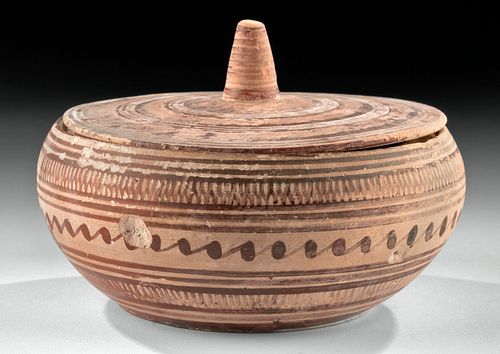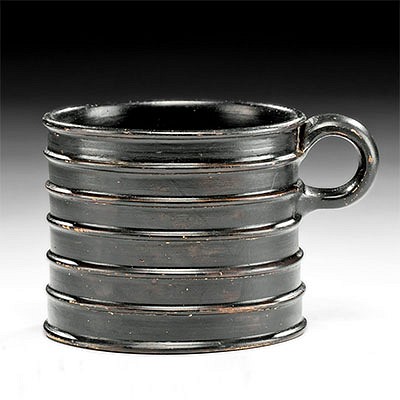Greek Geometric Lidded Pyxis, ex-Royal Athena
Lot 18a
About Seller
Artemis Gallery
686 S Taylor Ave, Ste 106
Louisville, CO 80027
United States
Selling antiquities, ancient and ethnographic art online since 1993, Artemis Gallery specializes in Classical Antiquities (Egyptian, Greek, Roman, Near Eastern), Asian, Pre-Columbian, African / Tribal / Oceanographic art. Our extensive inventory includes pottery, stone, metal, wood, glass and textil...Read more
Categories
Estimate:
$3,400 - $5,100
Absentee vs Live bid
Two ways to bid:
- Leave a max absentee bid and the platform will bid on your behalf up to your maximum bid during the live auction.
- Bid live during the auction and your bids will be submitted real-time to the auctioneer.
Bid Increments
| Price | Bid Increment |
|---|---|
| $0 | $25 |
| $300 | $50 |
| $1,000 | $100 |
| $2,000 | $250 |
| $5,000 | $500 |
| $10,000 | $1,000 |
| $20,000 | $2,500 |
| $50,000 | $5,000 |
| $100,000 | $10,000 |
| $200,000 | $20,000 |
About Auction
By Artemis Gallery
Mar 12, 2020
Set Reminder
2020-03-12 10:00:00
2020-03-12 10:00:00
America/New_York
Bidsquare
Bidsquare : Ancient / Ethnographic Around The World
https://www.bidsquare.com/auctions/artemis-gallery/ancient-ethnographic-around-the-world-4957
Ancient art from Egypt, Greece, Italy and the Near East, as well as Asian, Fossils, Pre-Columbian, Native American, African / Tribal / Oceanic, Spanish Colonial, Russian Icons, Fine art, much more! Artemis Gallery info@artemisgallery.com
Ancient art from Egypt, Greece, Italy and the Near East, as well as Asian, Fossils, Pre-Columbian, Native American, African / Tribal / Oceanic, Spanish Colonial, Russian Icons, Fine art, much more! Artemis Gallery info@artemisgallery.com
- Lot Description
Ancient Greece, Geometric Period, ca. 8th to 7th century BCE. A gorgeous wheel-thrown offering vessel known as a "pyxis" with a flat base, a wheel-form body with a sloping shoulder, a thin rim with an overhanging ridge meant to hold a lid, and a thin, discoid lid with a squat conical handle. Matte cream-hued slip envelops both body and lid to provide a soft ground atop which red-slip decorations are presented. Such vermilion embellishments include concentric rings of varying widths on the body, shoulder, lid, and handle, with dense zigzagging registers on the upper and lower body, and much wider zigzags coursing across the midsection. The interior ridge and lid bear two pairs of drilled tie holes so both components could be cinched shut during transportation or burial. A fantastic example of ancient Greek Geometric artistry! Size (w/ lid): 6.5" W x 4.5" H (16.5 cm x 11.4 cm).
For a stylistically-similar example with more complex decorations, please see The Metropolitan Museum of Art, accession number 48.11.5a, b: https://www.metmuseum.org/art/collection/search/254598
Another stylistically-similar example, of a larger size and with more complex geometric adornments, hammered for $18,750 at Christie's, New York "Antiquities Including Property from the Collection of Max Palevsky" auction (sale 2364, December 9, 2010, lot 93): https://www.christies.com/lotfinder/ancient-art-antiquities/a-greek-pottery-lidded-pyxis-geometric-period-5385399-details.aspx?from=searchresults&intObjectID=5385399&sid=03c333d1-a97f-4b57-bde4-83b24fa6284b
Provenance: private Alabama, USA collection; ex-Roy Green collection; ex-Royal-Athena Gallery, New York, USA; ex-private old French collection, acquired in the 1950s
All items legal to buy/sell under U.S. Statute covering cultural patrimony Code 2600, CHAPTER 14, and are guaranteed to be as described or your money back.
A Certificate of Authenticity will accompany all winning bids.
We ship worldwide and handle all shipping in-house for your convenience.
#148665Lid is likely not original to the body based on positioning of drilled tie holes. Both lid and body have minor abrasions, with chips to underside and rim of lid as well as base and upper rim of body, light fading to original pigmentation, several small excisions on body, and heavy encrustations, otherwise intact and very good. Great earthen deposits and traces of original pigment throughout. Old inventory label and old inventory number written in graphite beneath base of body.Condition
- Shipping Info
-
All shipping is handled in-house for your convenience. Your invoice from Artemis Gallery will include shipping calculation instructions. If in doubt, please inquire BEFORE bidding for estimated shipping costs for individual items.
-
- Buyer's Premium



 EUR
EUR CAD
CAD AUD
AUD GBP
GBP MXN
MXN HKD
HKD CNY
CNY MYR
MYR SEK
SEK SGD
SGD CHF
CHF THB
THB
















